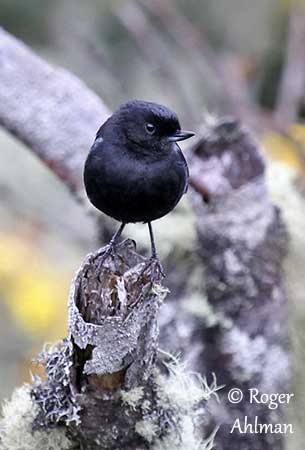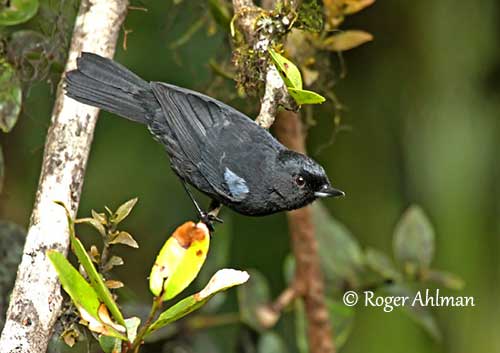
Fr: Percefleur de Lafresnaye
Ang: Glossy Flowerpiercer
All: Stahlhakenschnabel
Esp: Pinchaflor Satinado
Ita: Bucafiori lucente
Nd: Glansberghoningkruiper
Sd: glansblomstickare
Photographers:
Roger Ahlman
Pbase Galleries Peru and Ecuador
Tom Grey
Tom Grey's Bird Pictures & Tom Grey's Bird Pictures 2
Text by Nicole Bouglouan
Sources:
HANDBOOK OF THE BIRDS OF THE WORLD Vol 16 by Josep del Hoyo- Andrew Elliot-David Christie – Lynx Edicions – ISBN: 9788496553781
BIRDS OF SOUTH AMERICA – Passerines - by Robert S. Ridgely and Guy Tudor – HELM Field Guides – ISBN: 9781408113424
A GUIDE TO THE BIRDS OF COLOMBIA by Steven L. Hilty and William L. Brown - Princeton University Press – ISBN 069108372X
Neotropical Birds – Cornell Lab of Ornithology
Glossy Flowerpiercer
Diglossa lafresnayii
Passériformes Order – Thraupidae Family
INTRODUCTION:
The Glossy Flowerpiercer is a member of the genus Diglossa that includes small birds with strongly upturned bills, hooked at tip. This morphological feature allows the birds to feed by puncturing the bases of the flowers to reach the nectar.
This species is resident in Venezuela, Colombia, Ecuador and Peru. It is usually found at high elevations, in shrub and low forest near the treeline.
The Glossy Flowerpiercer is currently fairly common throughout the range and is not globally threatened.
The scientific name of this species pays tribute to Noël Frédéric Armand André Baron de La Fresnaye (1783-1861) French ornithologist and collector.

DESCRIPTION OF THE BIRD:
Biometrics:
Length: 14-15 cm
Weight: 13-19 g
The Glossy Flowerpiercer has glossy black plumage overall, with conspicuous, small, triangular pale blue-grey patches on shoulders. Flight-feathers, tail and underparts are often duller, with some gloss only on breast and body sides.
On the head, the area from forehead to supercilium is more velvety black.
The upturned bill is black with hooked upper mandible and sharply pointed lower mandible, the latter with silvery base. The eyes are deep reddish-brown. Legs and feet are dark grey.
Male and female are similar.
Juvenile and immature have mostly brownish-black plumage with faint shoulder patch.
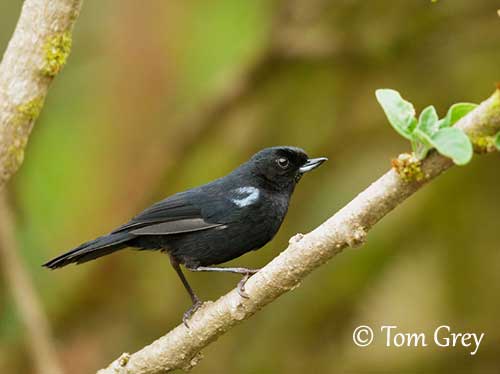
RANGE:
The Glossy Flowerpiercer is resident in its range. It can be found in the Andes of Venezuela, S to Colombia, S Ecuador to N Peru.
In Colombia, it occurs en Norte de Santander. There is an isolated population in Cundinamarca in E Andes. In central range, it is found from Antioquia S to Quindio and Tolima, and in S from E Cauca and Hulla.
HABITAT:
The Glossy Flowerpiercer is relatively common in stunted and mossy forest, and humid scrub and shrubbery near the treeline. It may occur at high elevations, between 2000 and 3250 metres, with records at 2700-3700 metres.
At lower elevations, it can be seen near habitations, and it often frequents gardens with flowers and disturbed areas.
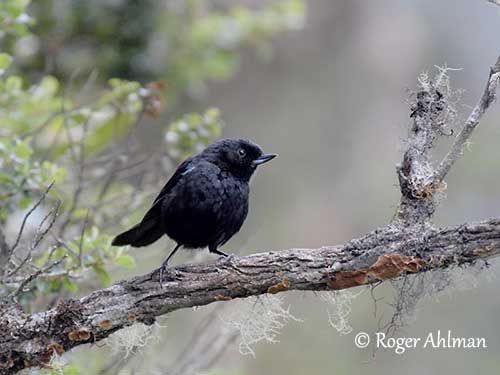
CALLS AND SONGS: SOUNDS BY XENO-CANTO
The song of the Glossy Flowerpiercer is a fast series of twittering notes, a high-pitched musical warbler of accented high notes and lower phrases, sometimes long-continued and lasting 15 seconds or more “chip chip chiiu chip chip chiiu…”
This song is usually given from exposed perch such as tip of small branch. The bird often disappears inside the vegetal cover after singing. Male and female sing.
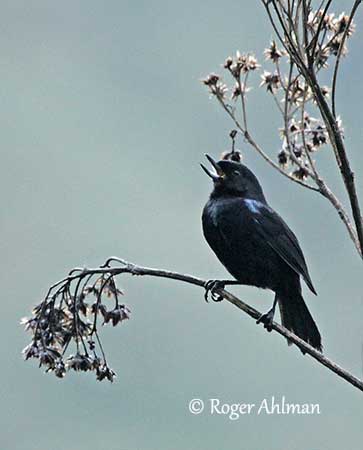
BEHAVIOUR IN THE WILD:
The Glossy Flowerpiercer feeds on nectar and insects. Insects are caught by short aerial sallies. Like other species of genus Diglossa, it feeds by puncturing the bases of the flowers to get the nectar. It often visits again the pierced flowers. It also visits hummingbird feeders.
It is shy and restless and feeds mainly inside the cover. It can be seen singly or in pairs.
From an observation, the Glossy Flowerpiercer also uses and maintains sap wells on shrubs (Asteraceae) on E slope of Andes of Ecuador.
This behavior is new for this species. The bird rotates among shrubs in trapline fashion, licking and drinking sap, dragging its peculiar bill along the wounds and the scars of the trunks, probably to keep the sap flowing.
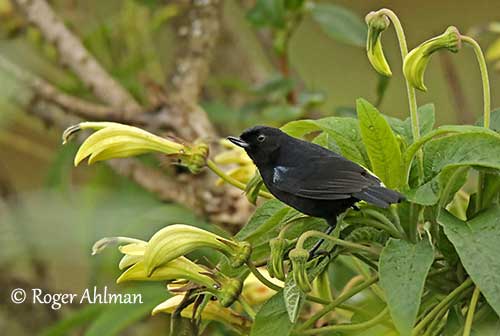
The Glossy Flowerpiercer is rather furtive. It hops quickly and secretively through the thick vegetation, coming occasionally into view or flycatching actively.
When it follows mixed-species flocks, it remains most often independent of the groups. It quickly crosses open spaces and dives into the vegetation.
During the breeding season, the territorial pair defends the territory. However, outside the breeding season, individual territories are strongly defended, as each bird maintains and defends its feeding areas, often small patches of flowers.
Dawn songs are uttered for exposed perch, in order to cover most of the territory. They are monogamous but the pair-bond is short, probably only one season.
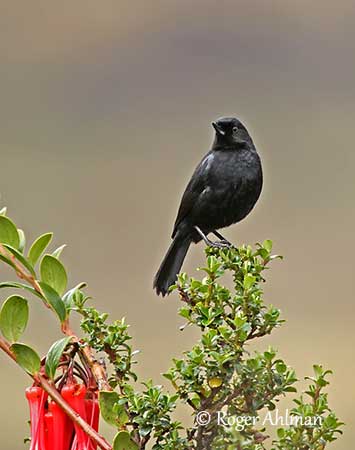
The courtship displays are not described for this species, but we can suggest that the obvious bluish-grey shoulder patches are enhanced by adapted postures accompanied by song.
The Glossy Flowerpiercer is resident. Some seasonal and altitudinal movements are closely related to food availability, and especially nectar from flowers.
The flight is fast while the bird crosses open spaces, before to dive into the dense cover.
REPRODUCTION OF THIS SPECIES:
The breeding season takes place between February and July. The nest is built in April/May and the season may extend to July/August.
A first description was done from a nest found in the Andes of S Ecuador in the National Park Podocarpus, in August 2015.
The nest is an open cup-shaped structure made with moss and woven rootlets. The cup is lined with finer moss fibers. It is placed at 130 centimetres above the ground, inside a shrub of genus Brachyotum. It appears bulky.
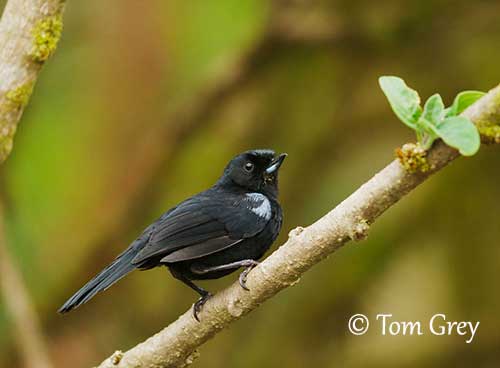
This nest was occupied by two chicks of about 1-2 days old. They were almost naked and with semi-open eyes. Some grey down was visible on head, nape and mantle. They were probably fed by both parents. No more information.
PROTECTION / THREATS / STATUS:
The Glossy Flowerpiercer is threatened by burning, cattle grazing and wood-cutting. However, this species is able to use settled habitats with human disturbance.
This species is inconspicuous but fairly common throughout most of the range. It is present in several protected areas in Venezuela, Colombia, Ecuador and Peru.
The population size is unknown, but it appears stable.
The Glossy Flowerpiercer is currently evaluated as Least Concern.
